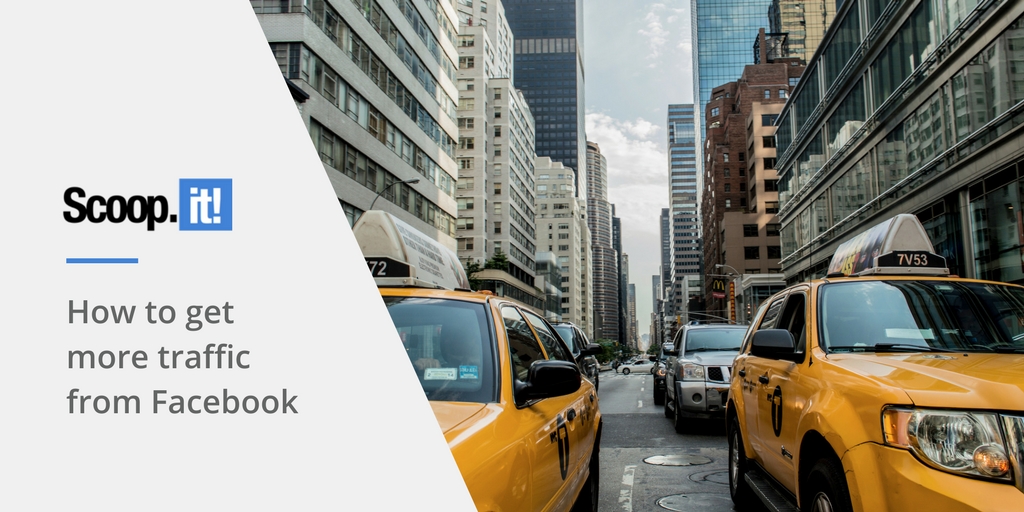
Traffic. It’s one of the most important drivers of content marketing. We create new content to attract it. We optimize existing content to attract it. We advertise for it. We partner for it.
We measure the results of our marketing by how much of it we get.
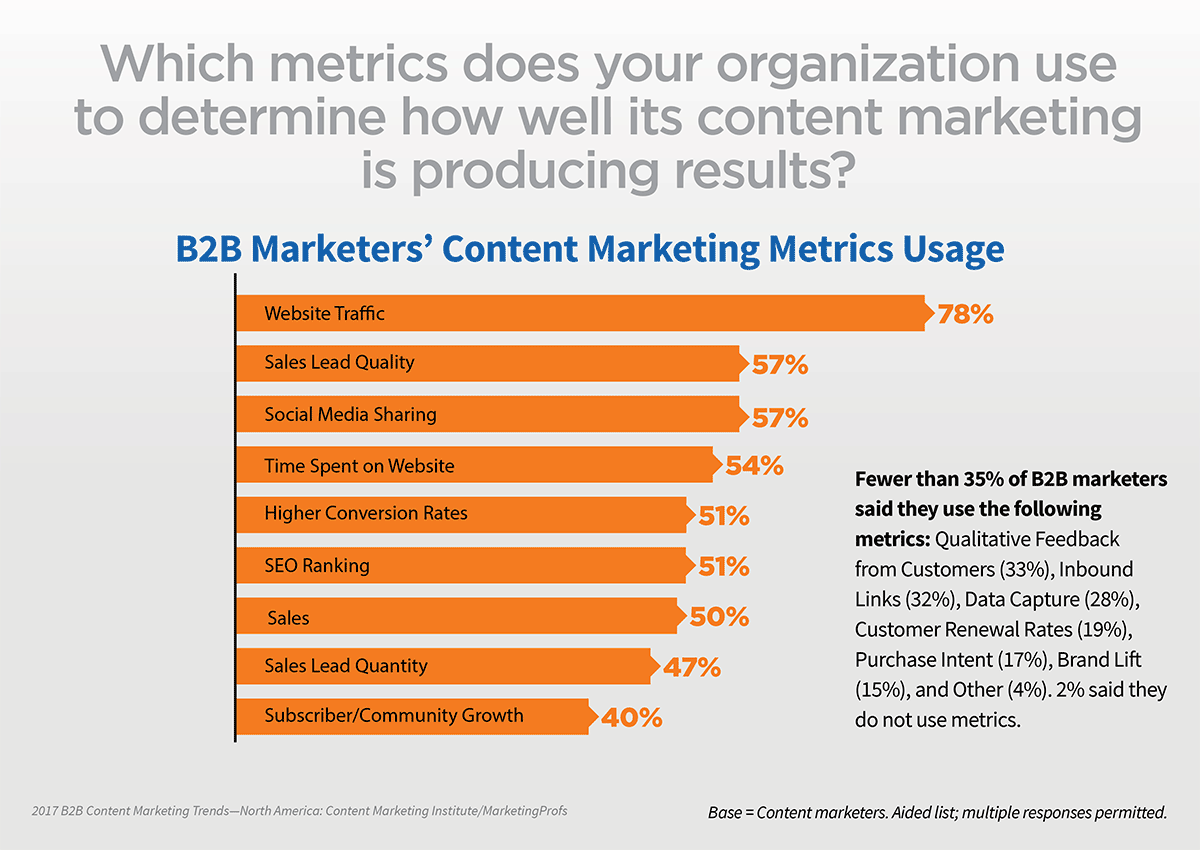
So where is all this traffic coming from?
Search engines, right? Google.
At least that’s where many of us think it’s coming from. If you look at the chart above and the chart below, search engine rankings are one of the major ways content marketers measure their work. And getting more traffic is one of their primary goals.

Also, notice the priority given on search engine rankings. In the Ascend2 graph and study, they found that content marketers view “improving search engine rankings” as a higher priority than even “improving return on investment.”
In the CMI/Profs chart above, “SEO Ranking” was a metric tracked more often than Sales, even.
Those two charts and the priority they give to search engine rankings show how heavily we associate referral traffic – traffic to our websites – with search engines. We optimize for search to get website traffic. (Duh).
This is all well and good, but there’s a new metric we’re missing. A new (newish) traffic source we need to adapt for.
Facebook referral traffic.
Ever so quietly, back in 2015, the amount of referral traffic from Facebook eclipsed the amount of referral traffic coming from Google.
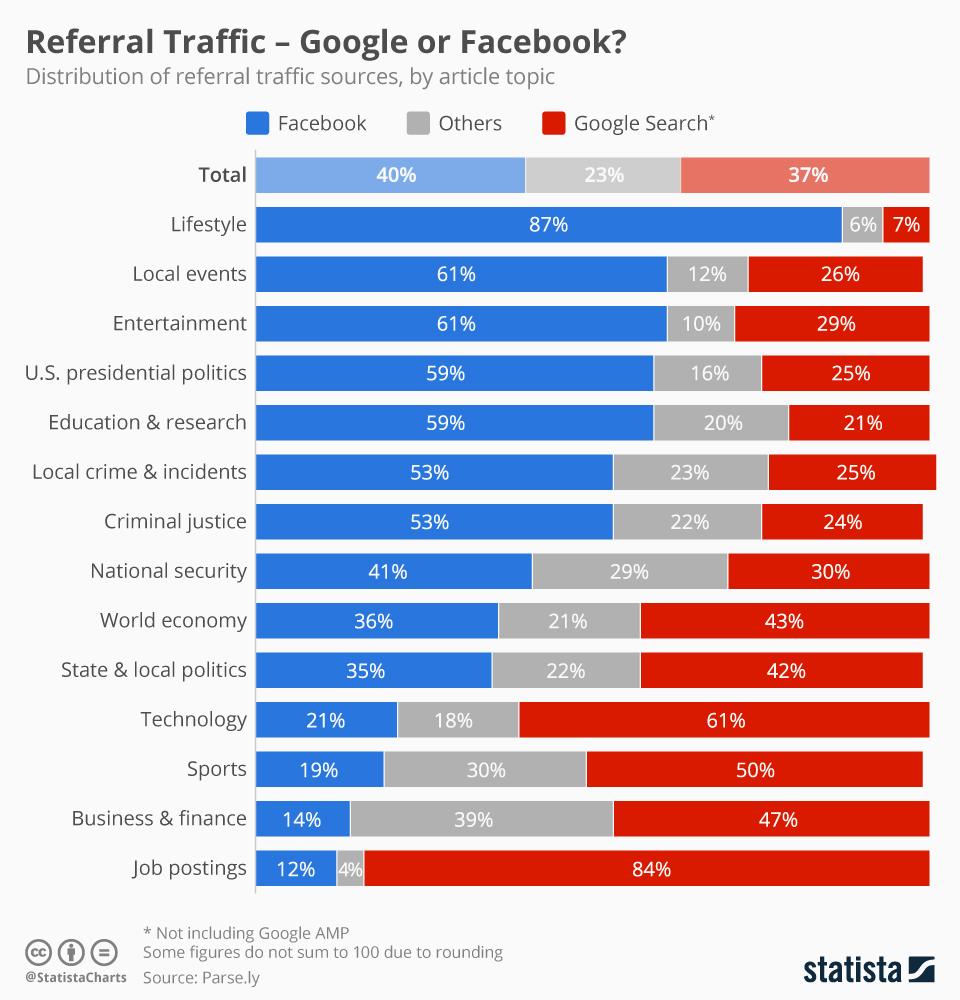
I barely believed this when I first saw it (“Fake news!”). But it confirms what’s been reported from other sources.
Now, while this is a big deal, keep in mind that there’s a push and pull here. Depending on which industry you’re in (as shown above), you’re more or less likely to have Google or Facebook be your top referral traffic source. And just in the last month, Google reclaimed its spot as the number one traffic referral source. Not by much, but by a little.
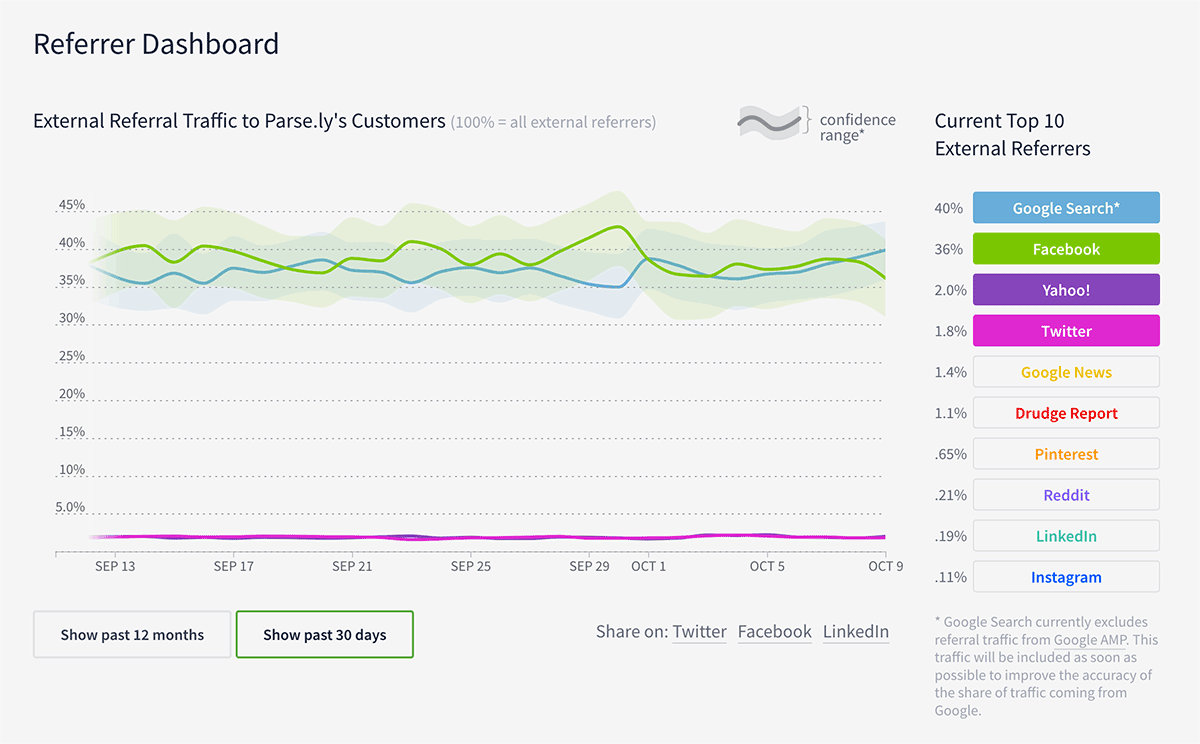
So don’t even think about saying Google doesn’t matter anymore. It absolutely, positively does. The point is that Facebook is driving as much traffic as Google is. But content marketers aren’t including Facebook’s referral traffic in either the metrics they track or in their goals.
There’s one other caveat about Facebook’s referral traffic: Not all traffic converts at the same rate. Search engine traffic tends to convert at a higher rate than social media traffic.
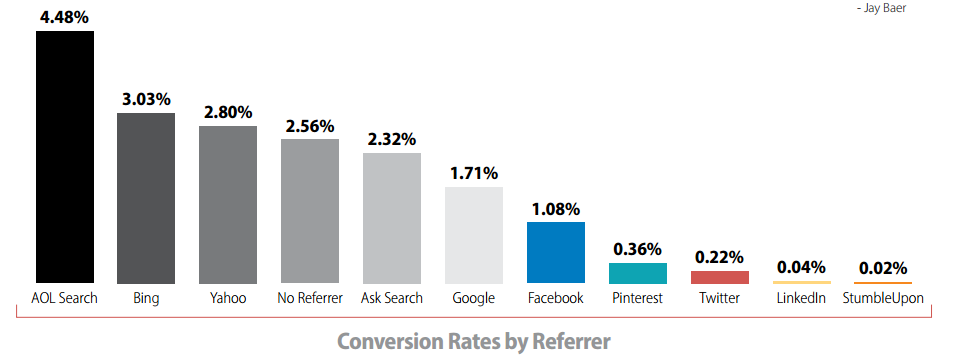
This means that even if you’re getting, say, 10,000 website visitors a month from Facebook, and only 7,000 website visitors a month from Google, Google may still be the better traffic source – and thus more worth your time and effort.
Here’s how it might break out (these conversion rates are only an example):
| Monthly visitors | Conversion Rate | Total Orders | |
| From Facebook | 10,000 | 0.50% | 50 |
| From Google | 7,000 | 1.10% | 77 |
Despite those caveats, perhaps it’s time for us content marketers to acknowledge this referral traffic from Facebook. Even if we’re in B2B.
Facebook is for B2B marketers, too
Many B2B marketers (myself included), have shied away from Facebook because we thought of it as a B2C platform.
That’s no longer the case. This year – for the first time – B2B marketers said that Facebook was their in Social Media Examiner’s 2017 Social Media Marketing Industry Report. “For the first time in the history of our study,” the report reads, “Facebook has passed LinkedIn as the most important platform for B2B marketers.”
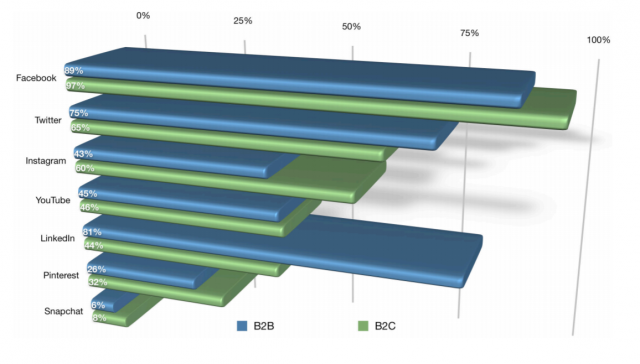
Platforms used by B2B and B2C marketers, from Social Media Examiner’s “2017 Social Media Marketing Industry Report”.
So you’re out of that excuse, B2Bers. It’s no longer enough to say, “Yes, Facebook is a legit source of referral traffic” and then continue with business as usual.
It’s time to change how we measure our content’s performance and the goals we set for our content. If we don’t, we’re missing out on a stream of referral traffic that’s roughly the same size as Google.
But what does that mean, really? How would you go about doing that with your business?
We have a few ideas:
1. Know how well Facebook’s traffic converts for your site
Before you invest too much into getting more Facebook traffic, it’s smart to figure out what that traffic is worth to you. Namely, how well it converts.
Once you know how well the traffic you’re getting from Facebook converts, you’ll have an idea of what each Facebook visitor is worth to your business.
Knowing this “visitor value” metric helps to determine if you’re spending your time wisely. It can also help you prioritize your work, which is especially important for small teams who may have a long list of great opportunities, but not enough time to get to all those opportunities.
To figure out how well your Facebook traffic converts, look to simple tracking programs like Google Analytics, more specifically Google Analytics goals. These are events or actions you define (like someone submitting a lead generation form) that let you see where the people are coming from that are generating those leads.
You can also assign a dollar value to each event (each new lead generated, for this example). And you can break out your website traffic by channel easily, so you can see how well different channels convert.
Even something as simple as this will go a long way toward showing you if it’s worth chasing after more traffic from Facebook. But as you know, just because somebody submitted a lead gen form doesn’t mean they become a paying client.
So you may need a more sophisticated tracking system to let you follow people through their buyer’s journey – from Facebook click to website visitor, new lead to demo viewer, sales contact to new customer, and then hopefully even on to recurring customer.
With a smart enough system, you can even figure out how long the sales cycle is for each channel (both for Facebook traffic and other streams of traffic) and what the lifetime value of customers from each channel is worth.
Who knows, maybe Facebook people end up really just buying once, but search engine visitors end up buying five times. Or vice versa.
The only way to know is to track. And by tracking, you can save yourself literally months of work. Facebook traffic might be incredibly valuable… or not. Maybe your particular company should be spending more time on, say, LinkedIn. Or Pinterest. Or writing a weekly column for a major industry publication.
2. Format your posts for more engagement
The odds are extremely high you’re already posting content to Facebook. So the goal here is to just do it in a smarter way.
Part of that means formatting your posts to get more engagement. Part of that means studying your analytics to see which types of posts perform best for your audience. Part of that means posting at the right time.
There are dozens of studies and resources and blogs about how to get more engagement on Facebook. But here are just a few tips to get you started:
- Create posts specifically for Facebook. Don’t just put up the same text and image as you post to every other social network. There are enough people on Facebook to warrant a “custom”, Facebook-specific post.
- Posts with shorter text work better on Facebook. Aim for 20 words or less. Sometimes, much less.
- Photos are essential for posts on Facebook; videos are better. Especially short videos.
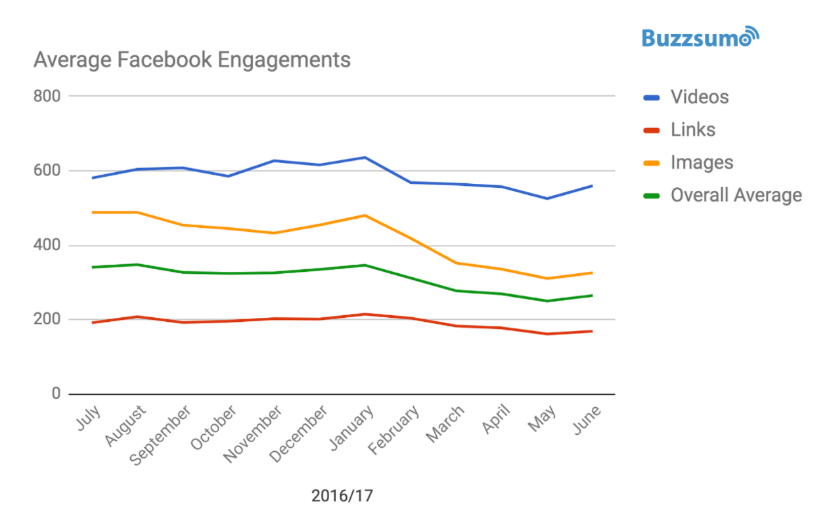
And yet, videos are published least often:
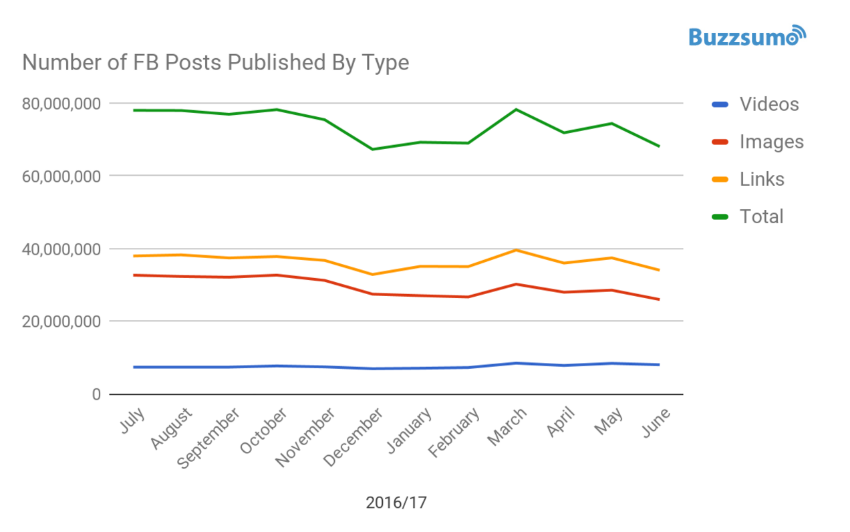
- If you post videos, post them as “native” Facebook videos, not reshared from YouTube. You’ll get two to seven times the engagement with native videos.
- Post or share (or ask for) user-generated content whenever possible. It gets 9 times the engagement as brand published content.
- Consider testing your content by advertising it as a dark post first (a “dark post” is Facebook-speak for an unpublished post). Then take the dark posts that have performed best and publish them to your Facebook page. This way, you’re only showing your followers content you know has performed better than average.
- Reshare your best-performing posts. Want to save a little time and effort? Want to get more visibility for your top-performing content? Reshare!
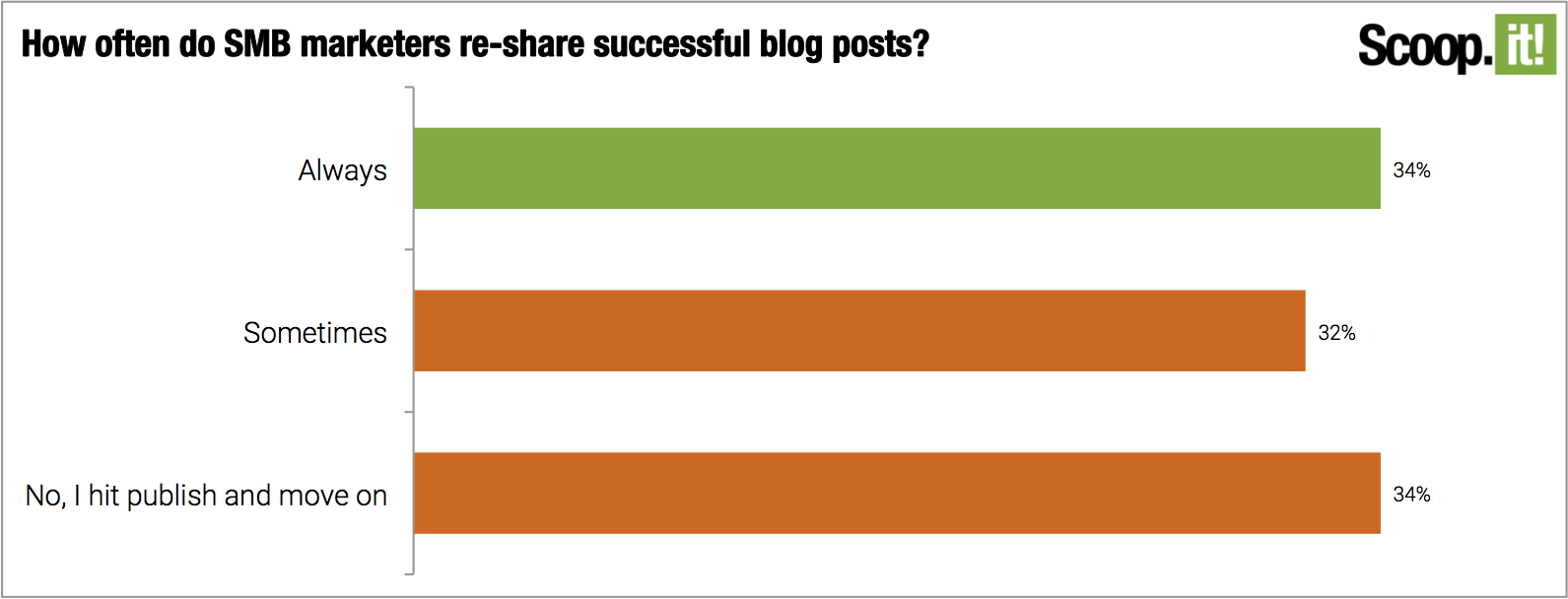
3. Have a content promotion budget
As you know, “marketing” on Facebook mostly means advertising on Facebook now. It is primarily an ad platform. Organic reach is generally in the single digits, even if you’ve got great content, formatted well, going out to an enthusiastic audience.
Most marketers are paying to promote content on social media. In the 2017 Content Marketing Institute and Marketing Profs Content Marketing Trends—North America report, 89% of B2C marketers and 84% of B2B marketers used paid social promotion.
Interestingly, both groups used paid social promotion more than any other tactic, though search engine marketing came in close behind.
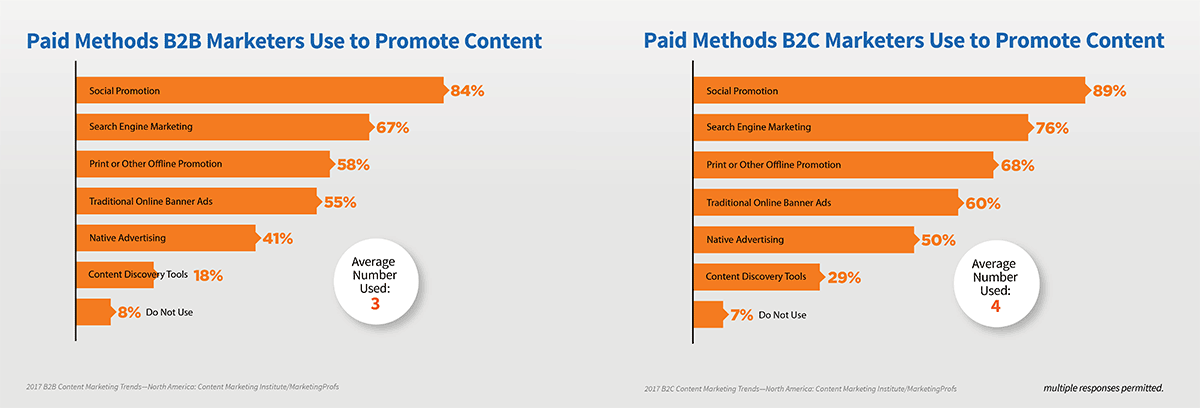
B2C marketers also said paid social promotion was their most effective way to promote content. B2B marketers were different: They said search engine marketing was most effective (though social promotion came in second place).
While paid promotion is necessary, there are smart and not so smart ways to do it. Guillaume Decugis walks through how to do it the smart way in his post, “How much money are you wasting on paid content promotion?” Basically, don’t promote content that didn’t do well organically. Ride the engagement wave – pay to promote content that is already doing well for you.
Conclusion
Like it or not, Facebook has become as much of a force in content marketing as Google and search. This is true even if you’re in B2B.
And we’ve only been looking at Facebook’s basic news feed and business pages – we haven’t included Facebook Messenger or Facebook Live or Facebook…. whatever-they-think-of-next.
The reality, for now, is that if this platform is going to refer so much traffic, it may be time for us to include Facebook referral traffic right up with search engine rankings in the metrics we track. Maybe our goals should shift, too – so that we commit to getting X thousands of Facebook clicks through to our site every month.
The right answer will be different for every company. Facebook traffic may not be worth chasing for everyone. But with this much potential, we’d be negligent to ignore it any longer.



Leveraging traffic from Facebook is critical to a content marketing strategy since no other platform has such strong targeting power.